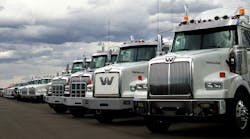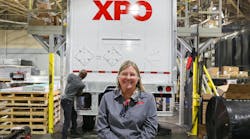The trucking industry is rapidly changing its perspective when it comes to the ubiquitous box that is the dry van trailer. According to Stuart James (pictured), vp-sales for Hyundai Translead, even small changes to a trailer’s interior dimensions can make a world of difference to a carrier’s bottom line and to the ability to extend the expected life cycle of trailers.
“Let’s look at our traditional ‘sheet and post’ dry van trailer, the HT Hy-Cube, and compare it to our new HT Composite model we now offer,” he told FleetOwner at the recent Technology & Maintenance Council meeting in Orlando, FL.
“When all is said and done, that composite trailer can offer a fleet ¾ of inch more in width – maybe a little less even,” he said. “But that extra amount of width can make all the difference in the world to a truckload or LTL carrier today in the general freight market, where many ‘cube out’ on loads before they reach maximum weight carrying capacity.”
Hyundai introduced its HT Composite design late last year, offering a full 101 ½-inch panel-to-panel interior width, built to allow for easy and rapid individual side-panel replacement without having to remove the stiffeners, which the company says results in less down time.
Yet while sheet and post and composite trailers are relatively equal in price today, big differences remain. For example, the material used to make a composite trailer’s sidewalls is considered hazardous and must be disposed of accordingly, James noted. Also, the majority of truckstops that offer trailer-repair services remain largely stocked with sheet and post materials and still lag in stocking composites.
Aside from those challenges, James said fleets are looking for other improvements, especially in terms of extending the potential life cycle of trailers. “We’re being told by our customers that they’ve been compelled to reduce the life expectancy of their trailers due to corrosion from liquid calcium chloride and other snow-removal chemicals. That’s why you are seeing so many corrosion-reduction solutions coming to the market for trailers now.”
He noted that Hyundai now offers a hot-dipped galvanized steel rear frame, rear-impact guard, landing gear mounting brackets and bracing, license mounting plate and mid-turn-signal bracket for more corrosion resistance.
Usage patterns are also changing, James noted. Many truckload fleets – which tend to put 100,000 miles a year on their trailers – are turning them more frequently to gain more residual value. On the private fleet side, however, they are looking for absolute longevity as they put fewer miles on their trailers.
“Total cost of ownership is becoming the key now – how can I maximize my trailer’s productivity and useful life, while minimizing downtime and maintenance cost,” James said. “That’s why you are seeing far more technology packed on trailers today – tracking devices, automatic tire inflation systems, etc. It’s all about asset management now, which is creating a sea change, if you will, in terms of how fleets view their trailers. They are no longer just boxes on wheels anymore to them.”




